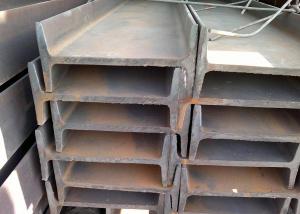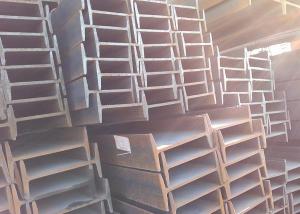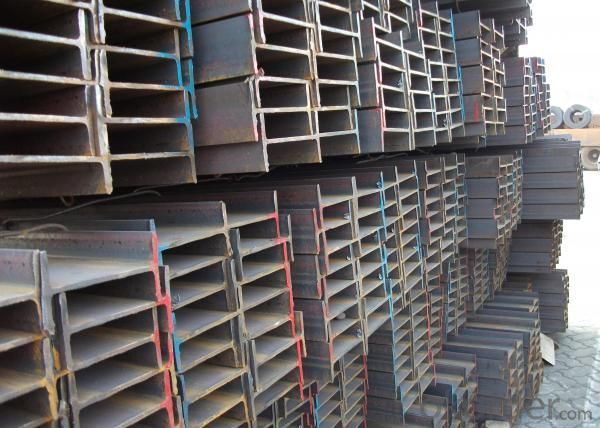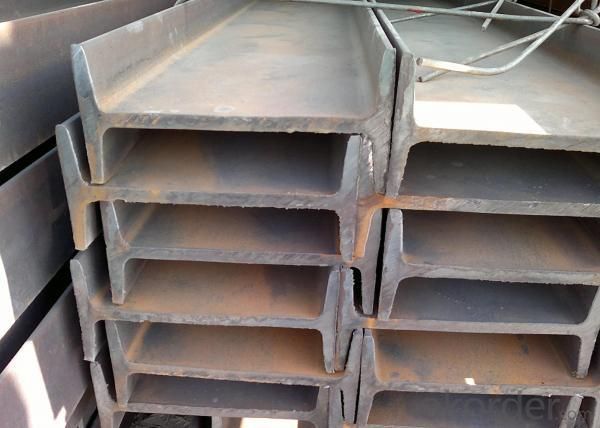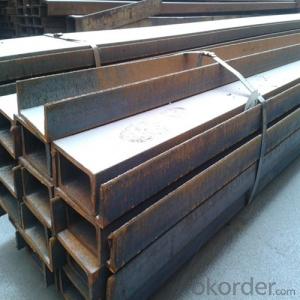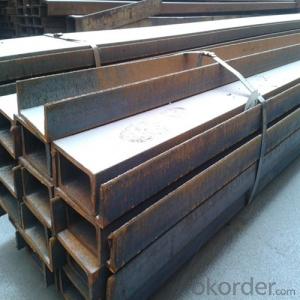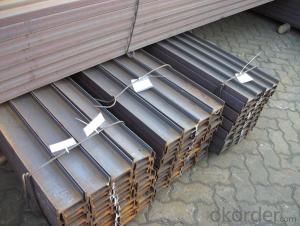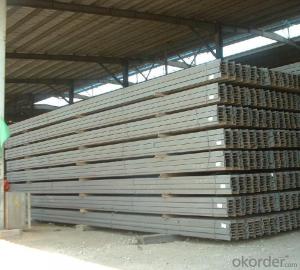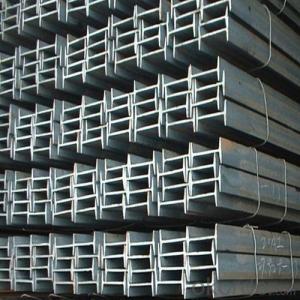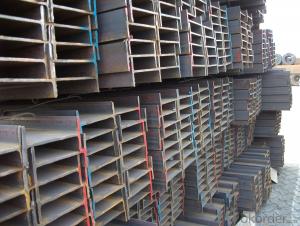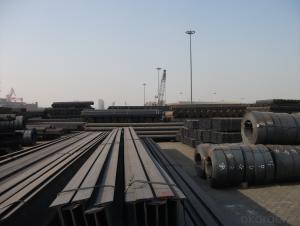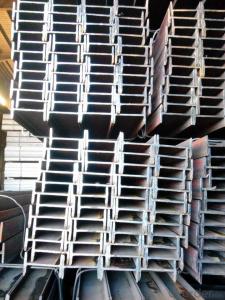IPE Beam
- Loading Port:
- Tianjin Port, China
- Payment Terms:
- TT or LC
- Min Order Qty:
- 10MT m.t.
- Supply Capability:
- 10000MT m.t./month
OKorder Service Pledge
OKorder Financial Service
You Might Also Like
Specifications of IPE Beam
1. Invoicing on theoretical weight or actual weight as customer request
2. Standard: EN10025, GB Standard, ASTM
3. Grade: Q235B, Q345B, SS400, ASTM A36, S235JR, S275JR
4. Length: 5.8M, 6M, 9M, 12M as following table
5. Sizes: 80mm-270mm
|
Dimensions(mm) | |||||
|
|
h |
b |
s |
t |
Mass Kg/m |
|
IPE80 |
80 |
46 |
3.80 |
5.20 |
6.00 |
|
IPE100 |
100 |
55 |
4.10 |
5.70 |
8.10 |
|
IPE120 |
120 |
64 |
4.80 |
6.30 |
10.40 |
|
IPE140 |
140 |
73 |
4.70 |
6.90 |
12.90 |
|
IPE160 |
160 |
82 |
5.00 |
7.40 |
15.80 |
|
IPE180 |
180 |
91 |
5.30 |
8.00 |
18.80 |
|
IPE200 |
200 |
100 |
5.60 |
8.50 |
22.40 |
|
IPE220 |
220 |
110 |
5.90 |
9.20 |
26.20 |
|
IPE240 |
240 |
120 |
6.20 |
9.80 |
30.70 |
|
IPE270 |
270 |
135 |
6.60 |
10.20 |
36.10 |
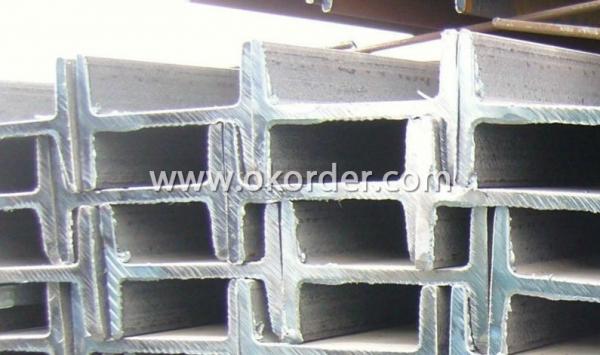
Appications of IPE Beam
1. Supporting members, most commonly in the house raising industry to strengthen timber bears under houses. Transmission line towers, etc
2. Prefabricated structure
3. Medium scale bridges
4. It is widely used in various building structures and engineering structures such as roof beams, bridges, transmission towers, hoisting machinery and transport machinery, ships, industrial furnaces, reaction tower, container frame and warehouse etc.
Package & Delivery of IPE Beam
1. Packing: it is nude packed in bundles by steel wire rod
2. Bundle weight: not more than 3.5MT for bulk vessel; less than 3 MT for container load
3. Marks: Color marking: There will be color marking on both end of the bundle for the cargo delivered by bulk vessel. That makes it easily to distinguish at the destination port.
4. Tag mark: there will be tag mark tied up on the bundles. The information usually including supplier logo and name, product name, made in China, shipping marks and other information request by the customer.
If loading by container the marking is not needed, but we will prepare it as customer request.
5. Transportation: the goods are delivered by truck from mill to loading port, the maximum quantity can be loaded is around 40MTs by each truck. If the order quantity cannot reach the full truck loaded, the transportation cost per ton will be little higher than full load.
6. Delivery of IPE Beam: 30 days after getting L/C Original at sight or T/T in advance

Production flow of IPE Beam
Material prepare (billet) —heat up—rough rolling—precision rolling—cooling—packing—storage and transportation
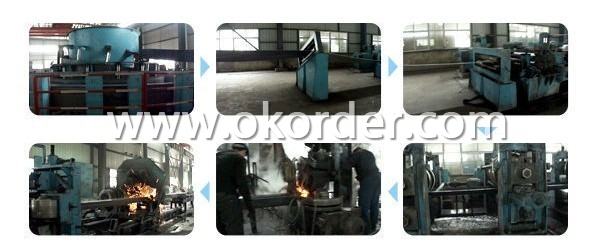
- Q: Can steel I-beams be used for mezzanines?
- Yes, steel I-beams can be used for mezzanines. Steel I-beams are commonly used in construction due to their strength and durability. They provide excellent structural support and can withstand heavy loads. Mezzanines, which are intermediate floors between main floors, require sturdy and reliable support to ensure safety and stability. Steel I-beams are ideal for this purpose as they offer the necessary strength and rigidity to support the additional weight of the mezzanine structure, including people, furniture, and equipment. Moreover, steel I-beams can be easily customized and fabricated to fit specific design requirements, making them a popular choice for constructing mezzanines in industrial, commercial, and residential buildings.
- Q: Are steel I-beams resistant to lightning strikes?
- Lightning strikes can occur on steel I-beams despite their conductivity. Despite steel being a good conductor, it does not guarantee immunity against lightning strikes. Lightning, a powerful natural phenomenon, can strike any structure made of steel. However, the risk of damage or fire caused by lightning can be reduced by implementing appropriate lightning protection measures. These measures typically involve the use of lightning rods, grounding systems, and surge protectors, which safely redirect the electrical charge to the ground, minimizing potential harm. It is crucial to seek advice from a professional engineer or lightning protection specialist to ensure that adequate measures are in place to safeguard structures, including steel I-beams, from lightning strikes.
- Q: What are the different types of steel coatings available for I-beams?
- When it comes to coating I-beams with steel, there are various options available, each with its own unique advantages and properties. Firstly, hot-dip galvanizing is a widely used and effective method. This involves immersing the I-beams in molten zinc, resulting in a strong and corrosion-resistant coating. It is particularly useful for outdoor and marine applications, offering excellent protection against rust. Alternatively, paint coatings can be applied to I-beams to protect against corrosion and enhance their appearance. Depending on the desired level of protection, different types of paint coatings, ranging from simple primers to advanced multi-coat systems, can be used. These coatings are typically suitable for indoor and non-corrosive environments. In industrial settings where I-beams are exposed to aggressive substances or harsh conditions, epoxy coatings are often preferred. These coatings are known for their exceptional chemical resistance and adhesion properties. They offer a high level of protection against corrosion, abrasion, and chemicals. Another popular choice for coating I-beams is powder coatings. These coatings are durable, versatile, and environmentally friendly. They involve the application of a dry powder to the surface of the I-beams, which is then heated and cured to form a protective layer. Powder coatings provide excellent resistance to impact, moisture, and UV rays, making them suitable for both indoor and outdoor applications. Finally, metallic coatings, such as zinc-aluminum alloys or aluminum coatings, offer a sacrificial layer of protection to I-beams. Instead of corroding the steel, these coatings corrode themselves, creating a barrier against corrosion. Metallic coatings are commonly used in environments with high moisture levels or corrosive elements. To select the most suitable steel coating for I-beams, it is important to consider the specific requirements of the application, including the necessary level of corrosion resistance, the intended environment for the I-beams, and the desired lifespan of the coating.
- Q: How do steel I-beams perform in terms of sustainability and recyclability?
- Steel I-beams perform well in terms of sustainability and recyclability. Steel is a highly recyclable material, and I-beams can be easily recycled at the end of their lifecycle without losing their structural integrity. Additionally, steel production has become more energy-efficient and environmentally friendly over the years. The durability and long lifespan of steel I-beams also contribute to sustainability, as they require minimal maintenance and replacement, reducing waste. Overall, steel I-beams are a sustainable and recyclable choice for construction projects.
- Q: Can steel I-beams be used for curtain walls?
- No, steel I-beams cannot be used for curtain walls. Curtain walls are typically made from aluminum or glass, as they need to be lightweight and provide transparency. Steel I-beams are heavy and lack the necessary properties to support the weight of glass panels while maintaining structural integrity. Additionally, steel I-beams do not offer the aesthetic appeal and design flexibility required for curtain walls.
- Q: What are the considerations for sound insulation when using steel I-beams?
- There are several important factors to consider when contemplating sound insulation with steel I-beams. 1. Mass plays a significant role in sound insulation with steel I-beams. These beams are heavy, resulting in a higher mass per unit area compared to other materials. This increased mass helps to absorb and dissipate sound energy, reducing sound transmission. It is crucial to ensure that the beams are adequately sized and thick enough to provide the desired level of mass for effective sound insulation. 2. Damping is another important consideration. Steel is a rigid material that can easily resonate and transmit vibrations, which contribute to sound transmission. To minimize this, it is crucial to incorporate damping materials or techniques that can absorb and dissipate vibrations. Examples include using rubber pads or isolators between the steel beams and other structural elements, as well as applying acoustic sealants or damping compounds. 3. In addition to the steel beams themselves, it is necessary to address potential flanking paths. Flanking paths are indirect routes through which sound can travel, bypassing the insulated area. These paths can include connections between the beams and other structural elements, such as walls or floors. Identifying and sealing any gaps or openings that allow sound transmission is important to address these flanking paths. 4. Acoustic design considerations are also important when utilizing steel I-beams for sound insulation. The layout and arrangement of the beams in relation to the rest of the structure can impact the overall sound insulation performance. Proper spacing and strategic placement of the beams can help minimize sound transmission paths and improve the effectiveness of the insulation system. 5. It is often necessary to incorporate additional insulation materials or techniques for optimal sound insulation results. While steel I-beams contribute to sound insulation to some extent, using insulation panels, resilient channels, or acoustic ceiling systems can further enhance performance. Overall, when using steel I-beams for sound insulation, it is important to consider factors such as mass, damping, flanking paths, acoustic design, and additional insulation techniques. Consulting with a professional acoustic engineer or insulation specialist can be helpful in determining the most appropriate solutions for specific applications.
- Q: Can steel I-beams be used in water or wastewater treatment plant renovation projects?
- Steel I-beams are a suitable option for water or wastewater treatment plant renovation projects. Their strength, durability, and versatility make them commonly used in construction projects. In the case of water or wastewater treatment plant renovations, where there is a need for heavy loads and high structural requirements, steel I-beams are an ideal choice. They can be utilized for various purposes, including supporting large tanks, bridges, walkways, and platforms. Moreover, steel I-beams exhibit excellent resistance to corrosion, which is crucial in water or wastewater treatment plants where exposure to corrosive elements is common. Overall, steel I-beams provide a reliable and cost-effective solution for water or wastewater treatment plant renovation projects.
- Q: What are the different types of steel I-beam connections for beam-to-beam joints?
- There are several different types of steel I-beam connections that can be used for beam-to-beam joints. Some of the most common types include: 1. Welded connections: This involves welding the two beams together at the joint. It provides a strong and rigid connection, but requires skilled labor and can be time-consuming. 2. Bolted connections: This method involves using bolts and nuts to secure the beams together at the joint. It is easier to assemble and disassemble compared to welded connections, but may not provide as much rigidity. 3. Riveted connections: This traditional method involves using rivets to connect the beams. Although it is less commonly used nowadays, it provides a strong and durable connection. 4. Moment connections: These connections are designed to transfer bending moments between the beams. They are typically used in situations where the beams are subjected to heavy loads and require additional support. 5. Shear connections: These connections are designed to transfer shear forces between the beams. They are commonly used in situations where the beams are subjected to lateral loads or wind forces. 6. Slotted connections: This type of connection involves using slots in the beams to allow for adjustability and flexibility. It is often used when precise alignment or adjustment is required. It is important to consider the specific requirements of the project and consult with a structural engineer to determine the most suitable type of steel I-beam connection for beam-to-beam joints. Factors such as load capacity, structural design, and ease of installation should be taken into account when selecting the appropriate connection method.
- Q: Can steel I-beams be used for military structures?
- Indeed, military structures can utilize steel I-beams. Given their exceptional strength and durability, steel I-beams find widespread use in construction. These attributes render them suitable for numerous military applications, including barracks, hangars, command centers, and other infrastructure. With their ability to provide structural stability and endure heavy loads, steel I-beams prove ideal for military structures that must withstand extreme weather conditions or potential attacks. Moreover, the simple fabrication and assembly of steel I-beams allow for swift deployment of military structures in diverse locations.
- Q: Can steel I-beams be used in retail or commercial building construction?
- Yes, steel I-beams can be used in retail or commercial building construction. Steel I-beams are commonly used in construction due to their strength and durability. They provide excellent structural support and can withstand heavy loads, making them ideal for commercial buildings where large spans and open floor plans are required. Steel I-beams also offer versatility in design as they can be easily fabricated and connected to form various shapes and structures. Additionally, steel is a sustainable and environmentally-friendly material, making it a popular choice in modern construction practices. Overall, steel I-beams are a reliable and efficient option for retail or commercial building construction.
1. Manufacturer Overview
| Location | Tangshan, China |
| Year Established | 2009 |
| Annual Output Value | Above US$ 230 Million |
| Main Markets | Mid East; Southeast Asia; Korea |
| Company Certifications | ISO 9001:2008; |
2. Manufacturer Certificates
| a) Certification Name | |
| Range | |
| Reference | |
| Validity Period |
3. Manufacturer Capability
| a) Trade Capacity | |
| Nearest Port | Tianjin; |
| Export Percentage | 81% - 90% |
| No.of Employees in Trade Department | 21-50 People |
| Language Spoken: | English; Chinese; |
| b) Factory Information | |
| Factory Size: | Above 500,000 square meters |
| No. of Production Lines | 1 |
| Contract Manufacturing | OEM Service Offered; |
| Product Price Range | Average |
Send your message to us
IPE Beam
- Loading Port:
- Tianjin Port, China
- Payment Terms:
- TT or LC
- Min Order Qty:
- 10MT m.t.
- Supply Capability:
- 10000MT m.t./month
OKorder Service Pledge
OKorder Financial Service
Similar products
Hot products
Hot Searches
Related keywords

